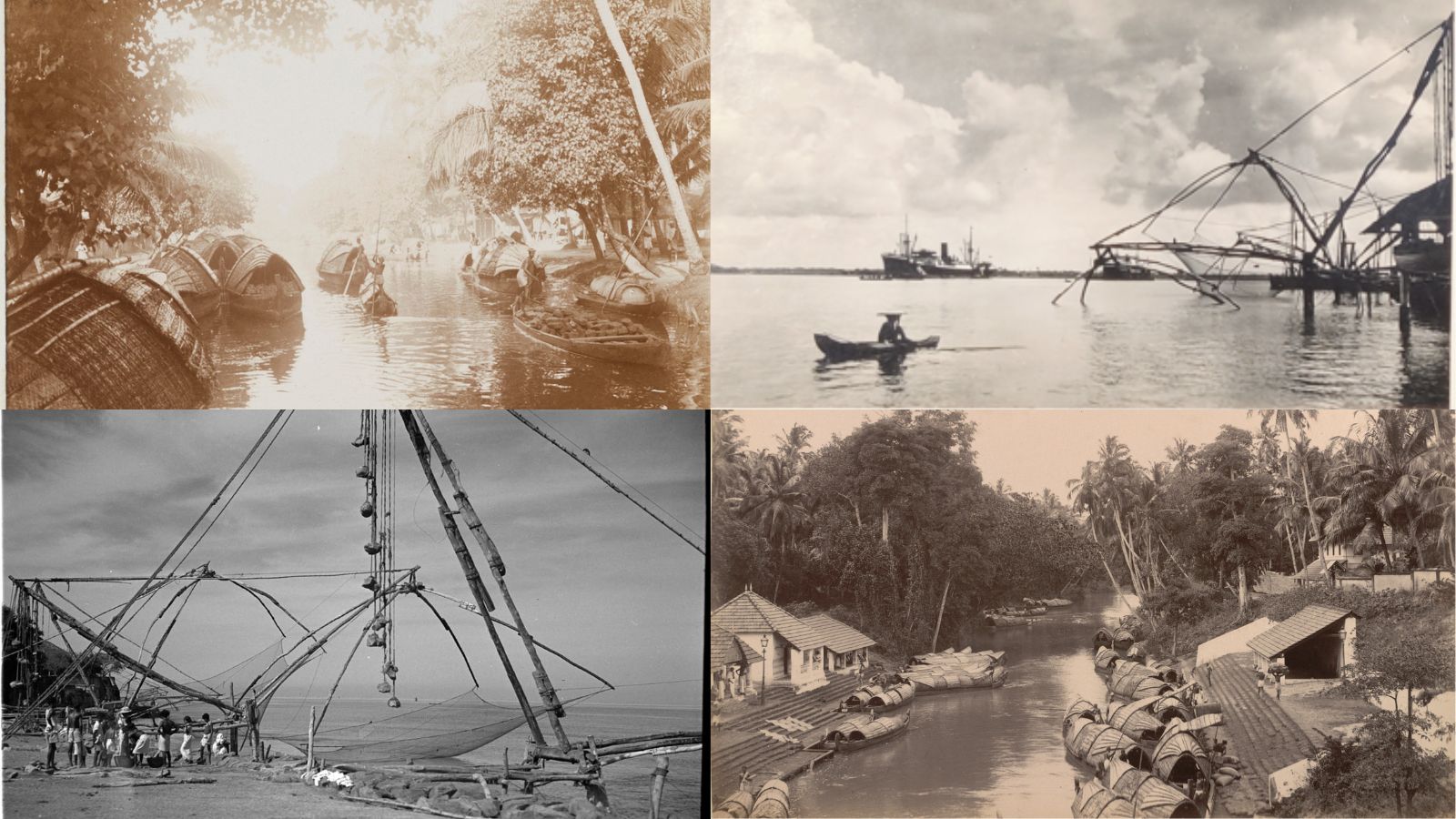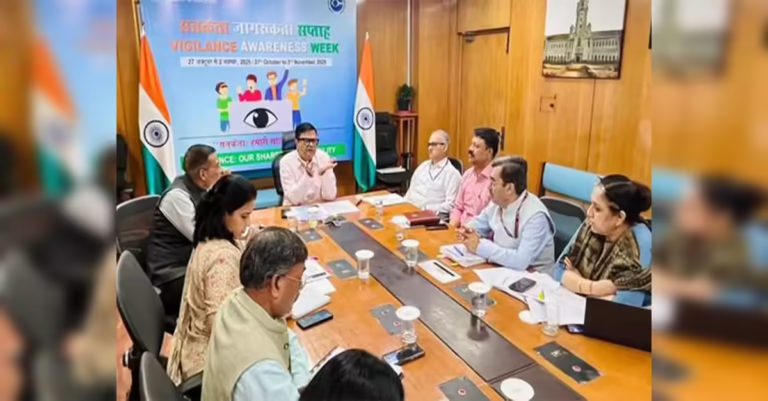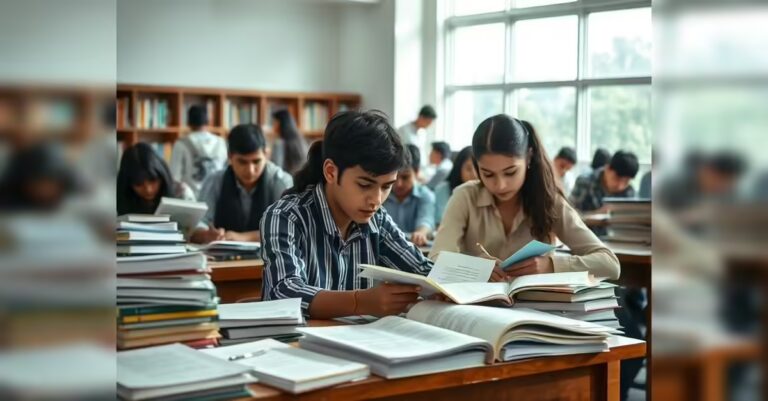
Colonial photographs of Kerala, today, when shared online, often evoke nostalgia. During the early 20th century, British officials created images that offer more than just picturesque glimpses of the past. The photos, bound into notebooks, travelled beyond Kerala, shaping how the region was seen and remembered. Today, they remain at once familiar and strangely distant. Let’s unbind 4 such photographic albums and take a closer look at what these colonial photos reveal and what they leave unsaid.

In the quiet of the Cambridge reading room, an image of Uncle Valarpadam emerges. Not the ‘uncle’ of my childhood, not the ones lounging with a newspaper in , but a British man in trousers and a cap, likely posed at the Goodacre’s coir yard. This ‘uncle’ is photographed, captioned, and remembered in someone else’s memory, in someone else’s archive – a colonial archive of Kerala. Somewhere between the curving margins of paper albums, between the slow scroll of digital shelves, a Kerala unfolds. A place built from the impressions, journeys, and intentions of those who arrived with cameras in hand and ideas of the land in mind. In the dafatir – stitched notebooks – of the colonial archive, photography writes Kerala in ways both revealing and estranging. What, then, do we read revisiting these archival pages, not merely as viewers, but as Keralites, retracing their steps?
Kerala within 4 different Colonial Archives
The four photographers I turn to in this dafatir are Nevill Forbes, Zachariah D’Cruz, Allen Campbell McKay and Christoph von Fürer-Haimendorf. Each of the archives stands apart in profession and purpose:
Nevill Forbes, an Oxford professor with a passion for travel, moved through towns like Trivandrum, Alleppey, and Cochin in 1907, recording the scenic views and their people.
Zachariah D’Cruz, a government photographer and mechanic of Portuguese-Indian descent, captured the landscape and public life of Travancore (c. 1900s) with a careful eye. The British Library holds an album by D’Cruz, once a gift to Lord Curzon. The 73 photographs in the album reveal a trained aesthetic, a layered composition where the ‘locals’ figure squarely within a broader tableau of landscape and labour.
Allen Campbell McKay, an assistant accountant at the National Bank of India Ltd, spent years in Cochin (1928–1932), photographing friends, homes, and “happy days.”
Christoph von Fürer-Haimendorf, an Austrian-British anthropologist, captured his travels through Kerala in the 1940s and 50s. He produced a systematic body of ethnographic photographs now housed at SOAS, London.
Bolgatty in archives: Colonial views across water and time
Although the four arrived with different eyes, their lenses evidently covered recurrent themes. One of which is Bolgatty – frames that contrast grandeur and a laid-back coastal life.

Haimendorf’s bungalow looms between the trees and water, to which D’Cruz positions the guards in the midground, giving life to the architectural capture. Could this be a zoomed-out view of what Forbes might have composed more informally? What we see is not a passive landscape, but is active and working, as one might read by placing various views of and from the Bungalow together. McKay’s images, for example, are full of life. “Lads and lasses” row boats, laugh on verandas, host parties: “Picturing happy days and jolly friends in Cochin. A record I can never forget.” Though it counters D’Cruz’s official tone, the vernacular warmth here gives life to these colonial representations.


The Backwater Scenes:

Seaming together McKay’s and D’Cruz’s Bolgatty backwater scenes is another way to read these colonial images closely. Compared to the different ‘views from the verandas,’ shoreline images capture the same world from the other side, expansive and populated, where figures walk along the sand and boats lie poised at the edge of activity. Both photographers work with depth and layering: people, trees, water, and movement exist in visual dialogue across the frame. Captured as part of “Lagoon Adventures,” McKay’s Bolgatty is not merely picturesque – it is personal. It is within this compositional convergence that we begin to see what united these frames across years and positionalities: the unmistakable draw of Kerala’s waterways.
Picturing the Backwaters: Colonial Enchantment and the Daily Life


From the silhouettes of Chinese fishing nets to the slow drift of Vallams laden with people, coir and coconut shells, the backwaters held a particular colonial enchantment. As McKay puts it, “Why the East fascinates.” His images, of life along the lagoons in Cochin and Alleppey, are tightly composed. Each image is a visual ode to motion, symmetry, and at times, his own ‘little make-believe”.
Similarly, in D’Cruz’s selected Dafatir, the same watery landscapes unfold as layered scenic arrangements; lagoons and boats stretch beyond the frame, evoking Victor Burgin’s idea of the photograph as both presence and absence.

The harmonic layering of human and non-human elements: trees, boats, netting, light, throughout all four albums, produces a “photographic event” – a moment not just of image capture but of situated social action. From the ‘Husband and Wife’ to the Brahmins and Christians on the Steamer, the colonial photographers did not fail to depict life onboard. By placing their lenses on the labourers as well as on ‘who’ is travelling, we are led to the next set of convergence – the portrayed people.
The portrayed people

Work seems to have come to a standstill at the Ponmanay Poothen Channel as heads turn to observe D’Cruz (what could have caused the disruption?). His style demonstrates a form of ethnography: a conscious positioning of human life within its landscape. By embedding his subjects within wider scenes in his album, D’Cruz manages to create movement: labourers looking up, women smiling, water rippling. They are static images, yet they begin to move the longer you gaze.
Haimendorf’s ethnographic portrayal of various communities across Kerala bears the mark of his anthropological training: posed, clear, comparative. They remind one of Edward Curtis’ typological images of Native Americans, of representations framed within colonial scientific paradigms. What emerges is not simply an aesthetic, but a way of seeing, and of making seen. Barthes’ notion of the “punctum”, the detail that wounds, that pierces, resides within these Dafatirs in quiet gestures.
Photographic style ultimately reflects intention.
D’Cruz’s photographs are precise, like a ledger. He was, after all, a government photographer and mechanic. McKay’s works are aesthetic, personal, and full of affect. Forbes’ images reflect a tourist’s gaze and Haimendorf’s typological, anthropological, and deliberate. But beneath these styles, however, lies the act of selection. Selecting what is deemed worthy of being photographed, worthy of being added to the Dafatir.
Colonial Postures, Caste Landscapes, and the Ethnographic Intent

What do you observe in the above images? Is it the rhythmic movement of labour? Is it the background? Or does your focus fall on ‘who’ is being portrayed? At first glance, these may seem to document the slow and daily life of the villages in Kerala. However, beneath their apparent simplicity lies a deeper ethnographic intent: to visually encode caste, labour, and gender into the landscape. These scenes are not merely records of activity; they are stitched registers of representations by the photographer. A prolonged interaction with the colonial archival photographs prepares us to think about how posture, power, and presence interweave.

McKay’s photograph of ‘Uncle Valarpadam’ (1929)
Let us return to McKay’s “Uncle Valarpadam”. It is 1929. He stands with feet apart, hands folded at his hips, grinning directly into the camera. This is a portrait of confidence, perhaps even satisfaction, as he poses in front of a coir-processing yard. His stance is relaxed, almost performative, and the smile suggests familiarity with the space he inhabits, not merely as a visitor, but as someone in control. Behind him stand two local workers – silent, blurred, anonymous.
Haimendorf’s ‘Nayar Man’ (1947)
Nearly two decades later, Haimendorf’s “Nayar Man” echoes this pose in a different register. He too stands upright, hands folded, but his gaze turns away from the camera – slightly off-centre, composed, self-assured. Behind him stretches what might be his family’s land, reinforcing the association of person, place, and ownership. Where Uncle Valarpadam’s posture embodies the confidence of an administrator entrenched in a colonial economy, the Nayar man’s gaze and grounded stance suggest pride rooted in caste and ownership.
What binds these two images with the image of Chetti houses in Kerala is not only their posed compositional similarity but also what lingers within – the built environment silently stitching presence with identities. From the colonial bureaucracy that McKay inhabits to the genmi (landlord) structure reflected in Haimendorf’s portrait, these photographs serve as visual documents of social order.


Visualizing the Ethnographic Intent
McKay’s albums, particularly the one he described as “largely educational”, take an unexpected turn within his otherwise personal collection. Amidst scenes of Cochin club gatherings and leisurely picnics with friends, he includes photographs of local industries such as coir production and paddy harvesting. Captioned as “Inspecting home industries,” the style reflects visual documentation with pedagogical intent, suggesting an embodied ethnographic curiosity. This echoes both D’Cruz’s as well as Haimendorf’s documentary style.
Haimendorf, in “Ploughing a field in upland Kerala,” frames his subject with ethnographic precision – the man, oxen, plough, and landscape are captured with compositional clarity, the subject carefully positioned mid-action, surrounded by ridged terrain and a Nayar Tharavad. While both McKay and Haimendorf use photography for ‘education,’ the type of knowledge conveyed differs. McKay’s Dafatir is stitched with nostalgia, colonial wonder, and a desire to represent ‘method’ without necessarily engaging the social layers; Haimendorf’s work, on the other hand, reflects the influence of Malinowskian fieldwork and photographic realism. His accompanying fieldnotes often include names, caste markers, and genealogies – avant la lettre: ethnographic data that rarely enter the frame of the photograph itself but remain deeply entangled with the image’s production. Why did McKay leave out the social layers and identities of the locals he photographed? Was it intentional?
Absences and Presence in the Colonial Archives

“This Kadar boy is demonstrating, for the photographer, how he uses his double-stringed pellet bow when hunting. Kadars typically hunted jungle fowl and birds,” reads the description. The above image is an overlay of two photographs taken by Haimendorf. Captured in a sequence of staged photographs, his firm grip, focused gaze, and subtle smile depict the performative ease with which he enacts the hunt for the camera. Haimendorf’s archive, rich with similar portrayals of other communities and occupations, blurs the line between ethnographic documentation and orchestration. Here, though the composition aids an illusory movement, something is visibly absent – an arrow.
These archives are as much about absence and staging as they are about presence and candidness.
What villages were never visited? What rituals went unrecorded? Whose names were never written down? Do Haimendorf’s notes contain the name of the Kadar boy and an explanation for the missing arrow? It is by asking these questions that one gets closer to understanding the “potential history” of photography, its possibility to be read otherwise, to be reclaimed. As a Malayalee reading what is there, and sensing what is not, I find myself asking: Who are the locals that layer McKay’s warm residential frame? Whose architecture eluded D’Cruz’s surveyed scenes? What were the stories behind the faces in Forbes’s steamer scenes? How much of Haimendorf’s catalogue was staged?
Photography, Roland Barthes wrote, is “that-has-been.” Light writes presence onto paper. And in these four archives, light traces layered histories: of the land, of people, of vision. McKay’s laughter-filled albums, Haimendorf’s performed anthropology, Forbes’ travelogue, and D’Cruz’s layered landscapes write Kerala. Their images now live on as prompts, as provocations, as mirrors. They are not just about the past; they speak to the present. They wait to be re-seen, re-narrated, re-imagined. And it is through their re-reading, through fragment, silence, and shadow, that we begin to reclaim our own way of seeing; we begin our own Dafatir.
This article is part of our Open Knowledge series (2025), supported by Wikimedia UK.







